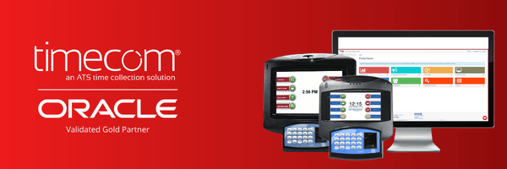Crafting a robust attendance policy is fundamental for any organization keen on boosting employee attendance. A well-defined policy helps the company use its workforce management tools such as an Oracle integration with a time tracking system, for maximum impact.
These integrated services combine attendance and scheduling data to enforce a policy, but a clear policy and standards must be defined first.
To gain insight on how to structure the attendance policy section of your employee handbook, we're sharing the six essential sections that every attendance policy must cover.
Customize these sections to fit your company's needs and create a successful attendance management strategy for your employees.

1.Work Hours
Define the typical hours of a workday. Clearly state any specific start and stop times. Describe any flexible time policy clearly, if your company has one.
Explain how the company tracks employee work hours as a visual builder to assist employee's knowledge of your policy.
Emphasize to employees the importance of using the Oracle integrated time clock to collect their work hours. Share with them some background on how the company carefully selected an Oracle-verified time clock system to ensure the accurate collection of their work hours.
 Reassure them that the time clocks are user-friendly and that instructions can be found on the time clock screen and next to each time clock.
Reassure them that the time clocks are user-friendly and that instructions can be found on the time clock screen and next to each time clock.
Ensure they understand how the Oracle-time clock integration improves payroll accuracy and ensures timely payments when they use the time clock during every shift.
2.Employee Absence Procedures
Clear guidelines help employees request time off without interrupting their work or managers.
Outline the business processes for:
- Submitting time off requests for approved absences.
- Providing a notification in case of unplanned employee absence.
Some absences are governed by specific laws. Your company’s procedures for employees to submit certain types of leave must comply with the applicable laws and regulations. For example:
- Family Medical Leave Act (FMLA): Employees may not be aware of the scope of the FMLA. This section should list the scenarios where an employee might qualify for FMLA, such as caring for a sick parent.
- The Uniformed Services Employment and Reemployment Rights Act (USERRA): Explain how your company handles military leave and reemployment, including when the nature of the call-up doesn’t allow the employee to give advance notice.

3. Eligibility and Availability Requirements
 Explaining when employees can get paid time off is important for fairness and transparency in your company's rules. Employees need to know all information when it comes to the companies PTO policies like:
Explaining when employees can get paid time off is important for fairness and transparency in your company's rules. Employees need to know all information when it comes to the companies PTO policies like:
- Is there a waiting period for new employees before they can submit for PTO?
- How many PTO days do employees earn each year?
- Where can employees see how many available PTO days they have?
- Are sick days and PTO managed separately from vacation or personal days?
4. Sick Leave
More companies have switched to a fixed number of paid days off without differentiating between scheduled time off and sick leave. If that’s your company’s policy, state it clearly in the policy.
If your company has separate policies for sick days and PTO, clarify the guidelines for employees who are sick. This will ensure that their time off is categorized as sick leave rather than PTO.
- Clarify the number of sick days allotted to each employee per specified time period (e.g. yearly, monthly).
- Let them know if partial sick days are allowed in case they need to leave early due to illness.
- Outline the carry-over policies for unused sick days.
- Explain the process and documentation requirements for getting approved sick leave.
- Define the difference between paid and unpaid sick leave.
5.Tardiness
Treat tardiness as seriously as absences. Excessive tardiness can be a symptom of low employee engagement, which could lead to high turnover. Allowing excessive tardiness may also encourage low productivity while at work.
When using an Oracle integration cloud service with your timekeeping solution, you can track tardies in near real time. Daily reports with your connectivity between your applications will help managers analyze which employees are often late and may also have excessive absenteeism.

6.Disciplinary Procedure and Consequences
Having a structured plan that addresses instances of unstructured work is as important as your employee attendance policy. When an individual is out of line or has a high number of late or sick days, disciplinary action should be taken. Your policy should be explicit about the consequences of not following your organization’s guidelines:
- Not following any of the procedures.
- Accruing unacceptably high rates of tardiness, absences, unexplained absences, or sick days.
Your handbook should also outline the disciplinary procedure, including:
Enforcing Attendance Policies with the Right Solution
A well-crafted attendance policy is vital to improving attendance and productivity. Yet, it’s insufficient without effective enforcement.
Integrating your Oracle solution with a time clock provides the tools and information you need to enforce your attendance policies.
Selecting an Oracle-certified time clock system, like ATS’s Timecom, ensures smooth integration with precise data mapping for seamless attendance tracking.
These applications integrate cohesively, providing accurate attendance information, thereby bolstering enforcement capabilities and policy adherence.
Crafting a Complete Attendance Policy
These six sections are the core of your employee attendance policy. Your policy can and should evolve to encompass additional components that align with your company's culture and expectations.
A robust employee attendance policy serves as a dynamic framework for promoting accountability and productivity within your organization.
To learn more about time and attendance and begin creating an Employee Attendance Policy that sticks, download our free eBook The Step-By-Step Guide to Minimizing Absenteeism. Or get in contact with a team member by clicking the button below.

While ATS is passionate about time and attendance and excited to support organizations navigate workforce dynamics around timekeeping, we recommend you reach out to your regional and/or local HR chapter for more information on common workplace advice and procedures.







